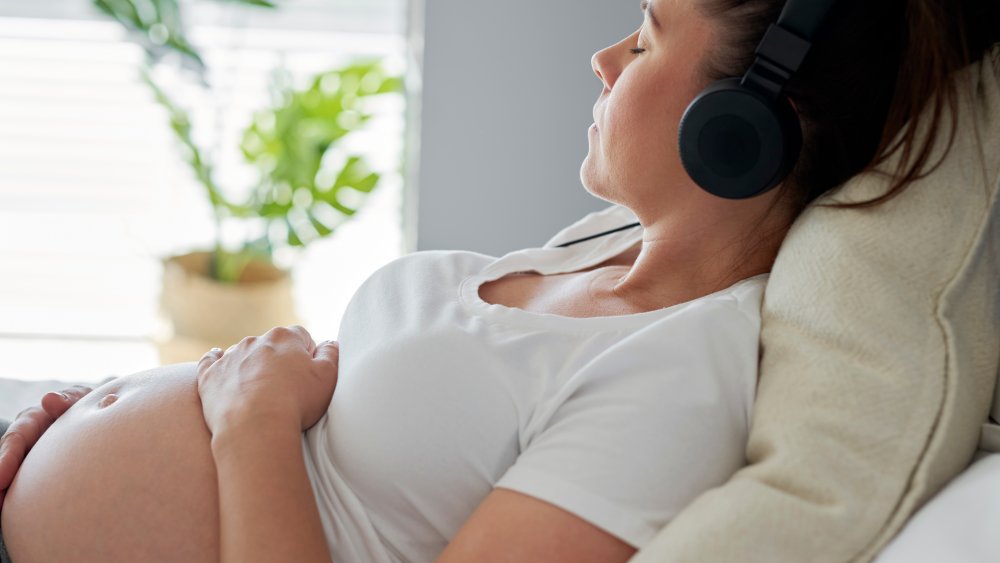Here's What You Need To Do To Prevent Tearing When You Give Birth
There's probably a point during every woman's pregnancy when she's looking at someone else's adorable baby and notices, with sheer terror, how very large and round its head is. Yes, something that size will be coming out of you, and it's possible you could end up with a tear of your perineum, the area between the vagina and anus. Some women need an episiotomy, a surgical procedure to create more room for the baby to pass through. Possible lasting side effects include pain during intercourse and incontinence.
But fear not: A tear is not a foregone conclusion. In an interview with The List, pelvic floor physiotherapist Dr. Joanne Wolf, DPT, explained that with proper planning, you can prevent or decrease your chances of tearing. "Perineal tearing, or perineal lacerations, can occur as a result of fascia and muscles being too rigid," she explained. Getting those muscles to be more flexible is key, and there are several different ways to accomplish this. They do require work, and the methods may take you out of your comfort zone at first, but Wolf says these efforts will be well worth your while.
Regular massages can help prevent tears
Especially if this is your first pregnancy, the muscles of your perineum are going to be tight, so massaging this part of your body is necessary to get ready for childbirth. You can perform the massage yourself or a partner can help you, which Wolf says can help you relax and focus on your breath, and releasing tension in this area.
According to Wolf, the ideal time to start doing perineal massage is around 34 weeks, but only after you've got your doctor's clearance to do this. You will want to perform the massage four to six times a week, in sessions that are five to 10 minutes each. "As the delivery date gets closer, I encourage women to be more diligent," Wolf added. The only tools you'll need are your hands or your partner's, which should be washed thoroughly, with nails cut short to avoid digging into the sensitive tissue, and some oil or lubricant.
How to do a perineal massage
Once your hands are clean and you've got oils at arm's length, get into a comfortable position. Wolf said a favorite of her patients is sitting with your back supported and knees bent. "If you can figure out a way to prop your knees up with pillows while still being able to position your hands properly, this will be the best option in order to relax all of the muscles in your hips and pelvic floor," she added. Next, you will want to apply oil and possibly lubricant to your fingers. "Insert thumbs into vagina up to 2 inches in a downward motion towards your anus, which is at 6 o'clock. Keeping slight downward pressure, loop the thumbs around towards 3 and 9 o'clock, stretching the perineum."
You likely will not love how this feels, but the discomfort is actually what you want to pay attention to, Wolf noted. "Anywhere that feels extra stretchy and burny, take some deep breaths and soften into the release," she explained. "It will make it that much easier during the birthing process when these tissues get even more stressed and the sensation will be familiar." As you're massaging, you may experience a wide spectrum of sensations: "You can ache, feel tingly, or you may feel heat emitting, and that is all normal," Wolf said. Hold each stretch for at least two minutes.
It's normal to find perineal massage uncomfortable
Since the point of perineal massage is to get your body used to a stretching and pulling sensations that ultimately will help push out your baby with more ease, you should go into this endeavor expecting discomfort — a max of 3 to 4 on a scale of 1-10 is to be expected, Wolf said. "The intensity should lessen after the first couple of weeks of consistently performing the technique," she added.
If you're finding it too difficult to do on your own, get some help. "Get your partner involved if they are up for it! Having someone else perform the technique will give you an opportunity to relax tension more fully in your upper body and allow you to focus on breathing and releasing tension throughout your whole body," Wolf said. You can also look into tools such as a pelvic wand, and the right lubricant can make a huge difference. You want to choose a product that is paraben free and pH balanced to avoid infection, such as BabyIt Perineum Massage Gel, which also can be used for postpartum relief.
How to have a tear-free labor
You've been diligent about perineal massage for weeks, and now it's show time: you're in labor. Wolf said it's important to place a warm, damp, sanitary compress on the perineum to keep the tissues relaxed and to increase tissue flexibility. This is an especially important as the baby is crowning. Have your partner, doula, midwife, or medical staff apply this as surely you'll have other things on your mind at that time!
Wolf also advises "smaller pushes and more of them instead of a few intense big ones, and breathing with as minimal holding of the breath as possible." When in doubt, she added, "your best option is to push when you feel the urge — when possible." You'll also obviously need to listen to your doctor, nurse, midwife, or doula for their cues. Your body position matters as well, Wolf noted. "Labor in positions that are more upright than the lying flat position — which you sometimes see in movies," she added. "This will be much easier on the body. Gravity will be your friend and you won't have to push as hard."




